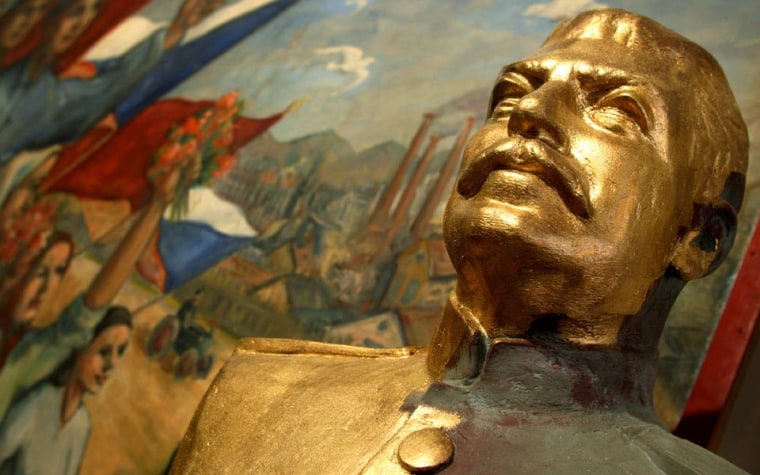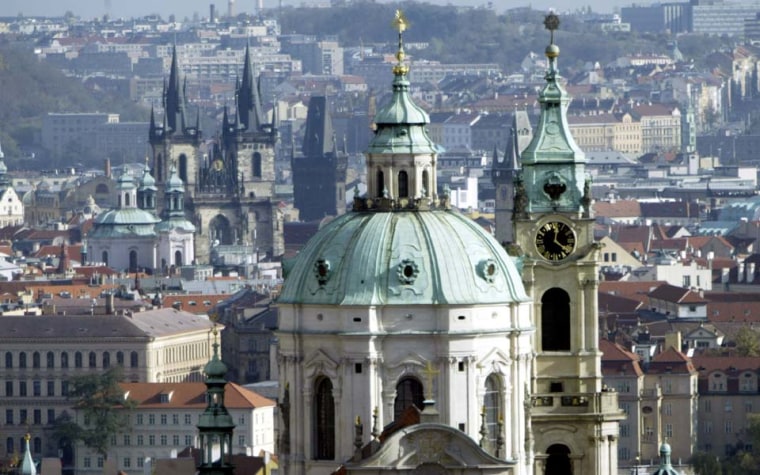Upstairs from a McDonald's and across the hall from a casino, Prague's latest attraction greets visitors with a hulking iron statue of Lenin and a whimsical poster: “Come see a 40-year episode of ‘Big Brother.’”
It's the Museum of Communism — just one of many points of interest in a now-unabashedly capitalist corner of the continent that's getting renewed attention from wanderers in the West.
Cities like Prague, Budapest, Bratislava and Warsaw long have beckoned young backpackers and other travelers who've already done London, Paris and Rome. They've been wide open to tourists since communism collapsed across eastern Europe 15 years ago, and even before that for those adventurous and tenacious enough to go to the trouble of getting a visa.

But the historic May 1 expansion of the European Union to take in 10 mostly ex-communist nations is putting these and other capitals of the “new Europe” on the radar of travelers looking for a change of pace or a fascinating diversion from a vacation to Austria, Germany or Scandinavia. The new countries are the former communist nations of Hungary, Poland, Slovakia, the Czech Republic, Slovenia, Estonia, Latvia, and Lithuania, as well as Cyprus and Malta, which were not part of Eastern Europe's communist empire.
Bratislava, the capital of Slovakia, is within easy day-trip range for those touring Austria. Like Prague, the Hungarian capital of Budapest is just a 45-minute flight or a 3 1/2-hour drive or train ride from Vienna.
Warsaw is a short flight, a 6-hour rail journey or an 8-hour drive from Berlin. And the capitals of the Baltic nations joining the EU this spring — Tallinn, Estonia; Riga, Latvia; and Vilnius, Lithuania — are doable for travelers touring Stockholm, which offers good air connections.
Increasingly, though, travelers are realizing these countries deserve a trip all their own so they can spend more time seeing how dramatically things have changed for those once locked firmly behind the former Iron Curtain.
Ah, Praha
The region's undisupted gem is Prague, rich beyond compare in art, architecture, cuisine, culture and history. Don't be put off by reports of damage from devastating floods in 2002; the city has recovered remarkably and teems with visitors year-round.
Wander the cobblestoned Old Town, dotted with restaurants, quaint taverns and the Old Town Hall's famed Astronomical Clock, which since 1410 has been tracking the motion of the sun and moon over Prague. Crowds gather on the hour to watch a succession of ornately carved figurines, including Death, Vanity and the Christian Apostles, appear in the tower.
A short walk off the square, past chic boutiques and cafes, gets you to the Jewish Quarter, home to some of Prague's most beloved architectural treasures and a place where time seems frozen in the mid-19th century. Check out the Pinkas Synagogue, the city's most famous memorial to the 80,000 Czech victims of the Holocaust, and the Jewish cemetery, jammed with ancient gravestones that jut out at odd angles like shark teeth.
Art lovers should make a detour down Michalska Street, home to at least eight galleries showcasing a wide range of original works by painters and sculptors from the Czech Republic, Russia, Ukraine, Armenia and farther afield.
From here, a warren of tiny streets lined with shops offering leaded crystal and hand-blown glassware leads to Wenceslas Square. In 1989, hundreds of thousands of protesters massed there, shouting speeches and spouting poetry in the Velvet Revolution that ended decades of communist rule.
Just around the corner is the Museum of Communism, worth a stop for history buffs. The museum opened in 2002, and it's packed with photographs and memorabilia that detail how the old regime spread its ideology and encouraged citizens to spy on each other. There's even a reconstruction of a police interrogation chamber where the stainless steel drains in the floor leave little to the imagination about how suspected traitors were treated. Humorous posters with slogans such as “Don't even think of visiting another museum or we'll send you to Siberia” help break the tension.
You'll need some fresh air, so consider a stroll across the ornate Charles Bridge, Prague's most famous span over the Vltava River. It will take you past dozens of artists and photographers offering their works for sale.
If your legs haven't given out by now, ascend the stairs to Prague Castle and take in the sweeping views. The medieval castle houses the offices of the Czech presidency and is the setting for numerous state dinners and other official functions. Parts of it are open to the public.
Prague has hundreds of top-notch restaurants offering world cuisine, but try the national dish of roast duck with dumplings and red cabbage. Wash it down with Budvar beer, a Czech brew the locals insist is the original Budweiser, or with a glass of dry Frankovka red wine.
Spas, gypsy orchestras, and great goulash
Prague is a great place to start, but don't overlook Budapest. With its buildings done up in the trademark yellow of the Austro-Hungarian Empire and its pleasant promenades along the Danube River, the Hungarian capital evokes Vienna but is spiced with an eastern flavor all its own.
Many visitors are surprised to learn that Budapest is really two cities, hilly Buda and flat Pest, separated by the Danube and linked with spans such as the Chain Bridge, whose hundreds of lights twinkle magically at night. It was destroyed by the Nazis but rebuilt after World War II.
Start with a ride on a funicular train to the hillside Castle District, home to bourgeois villas, the baroque Matthias Church and spectacular views.
If Prague's allure is its art, Budapest's is its public baths, built by the Ottoman Turks half a millennium ago. For centuries, they've been used by locals and foreigners who claim the natural hot springs that feed them have healing powers. Among the most intriguing is the Gellert bathhouse, an art nouveau wonder of mosaic floors, stained-glass windows and statues of swans.
Stop by Budapest's own little shop of communist horrors: the House of Terror, located in the building where Hungary's secret police beat, tortured and killed thousands of dissidents in the 1950s. Its centerpiece: an authentic mud-caked Russian tank on display inside.
Feast on — what else? — Hungarian goulash, or try the stuffed cabbage and chicken paprika. Hungary is making some eminently drinkable wines these days, among them Bull's Blood, a velvety red, and Tokaj, a sweet dessert wine.
Don't forget Poland
Warsaw may be one of the region's most underrated cities, but it's definitely worth exploring.
The Polish capital pulses with culture and nightlife. Winters can be bleak, but in summer, the city's leafy parks offer frequent open-air classical music concerts.
Grab a blanket and some pierogis — traditional dumplings stuffed with potatoes or cheese — and soak up the strains of Chopin, who spent his boyhood in Warsaw. There's a museum devoted to his early years.
Visit the Royal Castle, nestled on a plateau overlooking the Vistula River, which divides Warsaw into Parisian-style Left and Right banks.
For a glimpse into Poland's epic past, swing by the Pawiak Prison, where a third of the 100,000 people the Nazis locked up there never made it out alive. Or tour the Palace of Culture and Science, the nation's tallest building and a gift from Josef Stalin in 1955.
Other Easter gems
Vacationing in Vienna? Venture to tiny Bratislava, an hour's drive or train ride away. The Slovak capital has come a long way from its shabby communist-era days, notwithstanding its bleak Petrzalka concrete housing complex known as the "Bratislava Bronx."
Explore the medieval castle on a hill overlooking the Danube, which is temporarily housing the city's newest attraction: the Hockey Hall of Fame. Descend into the beautifully renovated city center and pose for pictures next to Cumil, a bronze statue of a man playfully peeking out from beneath a manhole cover.
Riga, Tallinn and Vilnius are even further off eastern Europe's not-so-beaten path, but the Baltic capitals hold some delightful surprises.
Take Riga's rich art nouveau scene. Or the medieval splendor of Tallinn's ancient center with its rose- and blue-colored cobblestones. Or venerable Vilnius with its narrow streets, eclectic mix of Gothic, Renaissance and Baroque buildings and its jarring Genocide Museum.
Just head east — and take a walk on the wild side.
Web links for move information
BALTICS: Visit http://www.balticsworldwide.com/. For Estonia, contact the Consulate General, (212) 883-0636, or visit http://tourism.ee/. For Latvia, contact the Latvian Embassy, (202) 726-8213, or visit http://www.ambergateway.com/. For Lithuania, visit http://tourism.lt/ or call Vytis Tours, (718) 423-6161.
BRATISLAVA: Visit http://www.bratislava.sk/ or call the Slovak Embassy, (212) 679-7044.
BUDAPEST: Visit http://www.gotohungary.com/ or call the Hungarian National Tourist Office, (212) 355-0240.
PRAGUE: Visit http://www.visitprague.cz/ or call the Czech Tourist Authority, (212) 288-0830.
WARSAW: Visit http://www.explore-warsaw.com/ or call the Polish National Tourist Office, (800) TO-POLAND.
SLOVENIA: Slovenian Tourism Office, (212) 358-9686.
